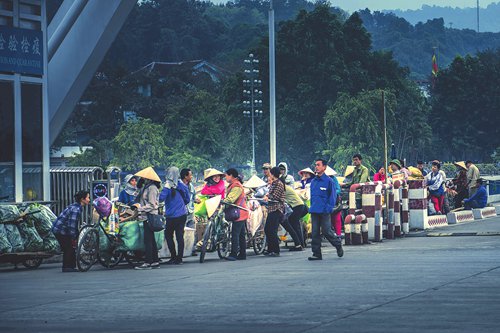Vietnam needs China to fulfill its 2045 dream of economic revival
By Ge Hongliang Source:Global Times Published: 2020/2/2 18:33:40

Some Vietnamese workers gather at Honghe, Southwest China’s Yunnan Province in March 2018. Photos: VCG
Prime Minister Nguyen Xuan Phuc said Vietnam should aspire to be a high-income country by 2045 when he met city and provincial leaders late last year.
To achieve this ambitious goal, there have been many things the Southeast Asian country is looking to develop at a faster pace.
Since Vietnam started a political and economic renewal campaign in 1986, its economy has made remarkable progress. By the late 1990s, the economy was growing at an annual rate of more than 7 percent. In 2019, Vietnam's GDP stood at $266 billion. This robust economic momentum can be attributed to three factors.
First, foreign capital inflows and advances in manufacturing, processing and emerging sectors have been the locomotive of Vietnam's economic growth. Foreign direct investment pledged to Vietnam exceeded $38 billion in 2019, with an increase of 7.2 percent compared to 2018. In 2019, the manufacturing and processing sectors expanded by 11.29 percent and industry and construction increased by 8.9 percent.
The second factor is Vietnam's export-oriented economy. Vietnam's trade turnover was estimated to be $516.96 billion in 2019, rising by nearly 8 percent year on year, of which exports accounted for $263.45 billion, growing 8.1 percent year on year, and imports were expected to total $253.51 billion, a rise of 7 percent, according to Hanoi Times.
The third element is the robust growth in the services sector, especially tourism and retail. The number of foreign tourists visiting Vietnam reached an all-time high of 18 million in 2019, up 16.2 percent year-on-year.
In line with the rules of economic development, it's not surprising for Vietnam to maintain this level of progress, which is a common characteristic of countries in the early stages of industrial development.
Take China, Japan and South Korea. Within three decades, since the beginning of its reform and opening-up in 1978, China's average annual growth rate stood at 9.8 percent. From the mid-1950s to early 1970s, Japan also experienced a period of high-speed growth. From 1965 to 1979, South Korea's real GDP annual growth averaged more than 9 percent.
Therefore, it would not be astonishing if Vietnam's economy enters a "golden era" over the next five to 10 years.
From a regional perspective, it shows the rise of emerging powers in Southeast Asia. In recent years, the economies of Southeast Asian countries have remained on a vigorous growth track that has been rarely seen in other regions of the world.
The Belt and Road Infrastructure Development Index Report 2019 said, "Southeast Asia maintains strong momentum and comes out first among seven regions for the third consecutive year." Indonesia, Vietnam, Malaysia were ranked as the top three countries in the region. "Six of the 10 Southeast Asian countries appear on the Top-20 list."
Foreign capital inflows, low labor costs, infrastructure development, and the growing middle class are the main factors contributing to the high-speed economic growth of these countries.
China has already passed the early phase of industrialization. This East Asian giant has experienced high-speed economic growth at an annual rate of over 10 percent.
As the second-largest economy, China is willing to see the rise of Southeast Asia's emerging countries, including Vietnam.
It remains to be seen whether Vietnam can achieve its vision for 2045. To fulfill this vision, Vietnam will have to maintain its current growth rate for the next two decades.
To maintain an enduring economic increase, Vietnam has to make more efforts. Rather than focusing on the growth rate, the country has to ensure the stability of its economic growth and to make sure it can make more breakthroughs in global industry chains.
Vietnam has to deal with a series of challenges, such as the sluggish world economy due to the US-launched trade war against China, and low productivity attributed to low labor quality and unmatched rise in labor costs.
Vietnam's rapid economic growth is directly related to China's giant economy. From January to November 2019, the trade volume between China and Vietnam reached $145.54 billion, up 8 percent year on year. It indicates deepening ties between the two countries' industrial chain.
China, it can be concluded, will play a significant role in Vietnam realizing its vision for 2045.
The author is deputy director with the College of ASEAN Studies at Guangxi University for Nationalities. opinion@globaltimes.com.cn
Posted in: ASIAN REVIEW,OTHER REGIONS